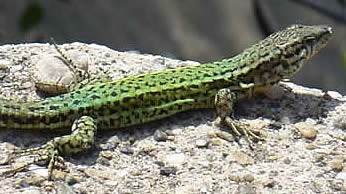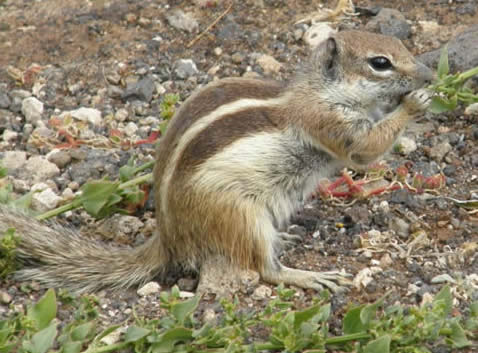Honeyguide news archive 2015
Six intrepid Honeyguiders have recently returned from mostly hot and dry Namibia. Highlights included the outrageous pink of large flocks of flamingos at Walvis Bay, and squabbling flamingos, francolins and dik-diks. Many mammal sightings included three cheetahs close to the vehicle in Etosha National Park, a lion on a giraffe kill and twelve mammal species around one waterhole. The landscape and geology also played a big part: sunsets, giant dunes, Swakopmund’s crystal gallery and all these things combined: “The amazing ability of wildlife to survive in what appears to be such inhospitable landscape,” as one group member put it.

Lesser and greater flamingos (Marion Hession); lion and massed mammals at a waterhole (Geoff Crane). Holiday report, Namibia 2015, here. A selection of photos by Honeyguider John Rumpus from November 2015 here.
Our Algarve & Alentejo group arrived in driving rain and it poured for much of the first day - on which a museum visit was the Plan B - but the weather then improved. Three species of both shearwaters and petrels on the pelagic trip included a close Wilson's storm-petrel, dancing over the sea and the 'chum' bait. On the plains there were great bustards, Europe's heaviest flying bird, and elsewhere there were close views of firecrests, the smallest, with crested tits. Other highlights included a yellow-browed warbler, Spanish imperial eagle on a carcass and a big group of Audouin's gulls.



Purple swamp-hen, pale phase booted eagle and chameleon (Barry Madden). Read Barry's account of this holiday (in October/November 2015) and see more of his photos on his Eastern Bushchat blog. Holiday report here.
News story here about the holiday's donation of €1000 to SPEA, with links to the excellent coverage in Portuguese media.
Our Morocco holiday base is a winner at the World Responsible Tourism Awards 2015 (November 2015). Gold Winner: Atlas Kasbah Ecolodge was the "Best Hotel for Local Sourcing sponsored by Colorado Tourism Office". |
|
"Judges' reasons for winning: Based in Morocco’s Argan Forest near Agadir, the judges were impressed by Atlas Kasbah Ecolodge’s ability to report in detail on its impact on the local economy, with 81% of money spent within a 50km radius, and staff employed from nearby Berber communities.
"By offering guests local experiences such as cooking and craft classes, and starting up an organic food basket scheme with deliveries in Agadir and neighbouring villages, Atlas Kasbah Ecolodge has successfully developed wide a range of economic activities with the local Berber communities to their mutual advantage." More information here.
 |
Also in Morocco, BirdLife International reports a "Record breeding success for Critically Endangered Northern Bald Ibis, " with 116 pairs and a fledging success of 1.7 young per pair. More here. |
Bald ibis (Igor Maiorano), supported by our conservation project on this holiday.
 |
There are more than 300 nestboxes for rollers in the area around Kondor Lodge in Kiskunság National Park, Hungary. Almost 90 per cent of the nestboxes were occupied by rollers and the others by scops owl, hoopoe and starling. The birds are there when Honeyguide visits, but where do they then go? Our host Gabor Orban reports that a ringed bird was found dead in Lebanon in September, which suggests a route around the eastern end of the Mediterranean to wintering grounds in sub-Saharan Africa. Roller (Martin Sabik). |
I write (says Chris, in October) having not long returned from South Africa's Southwest Cape, a Honeyguide holiday with a difference. On this occasion it wasn't in the brochure: it was a family holiday with three generation of Durdins, and Malcolm and Helen Crowder, who with me run the Honeyguide Wildlife Charitable Trust, were also there. Geoff Crane was our guide, as always in South Africa. There was fine selection of birds, flowers, mammals, reptiles, amphibians and dragonflies set in wonderful scenery and perfect weather. Do have a look at the photos on Facebook and the report here.
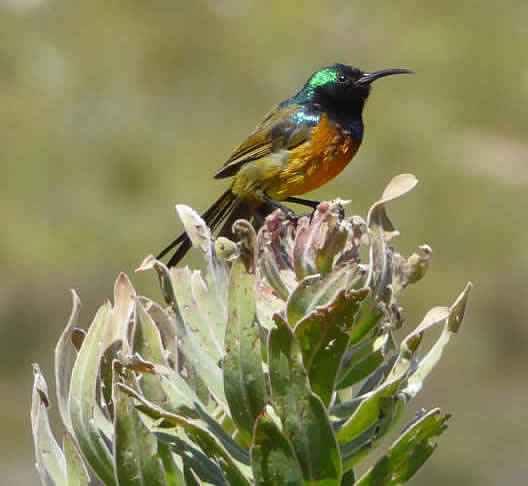


Southern double-collared sunbird, orange-breasted sunbird and malachite sunbird, all photos by Helen Crowder from South Africa's Southwest Cape.
Vultures in the Rhodope Mountains will be helped by a new EU LIFE project called 'Conservation of Black and Griffon vultures in the cross-border Rhodope Mountains.' This is an area known by Honeyguiders who have been in Dadia Forest in Eastern Greece, or the Eastern Rhodopes when our Bulgaria visited several places. The project is a collaboration between Rewilding Europe, WWF and the BirdLife partners in Bulgaria and Greece, BSPB and HOS, and others. It's another reminder of the value of the EU's Natura 2000 network and LIFE programmes. More details on the Rewilding Europe website.
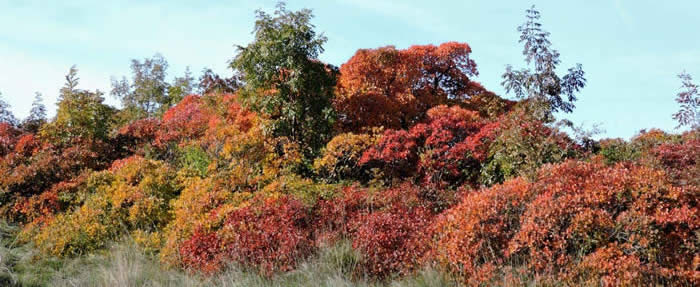
Autumn in the Karst, Italy/Slovenia: smokebush
Cotinus coggygria (Paul Tout)
From the Alps to the Adriatic: Honeyguiders in northeast Italy and Slovenia in September struck lucky with weather: rain before and after the holiday but warm sunshine during it. That probably encouraged the griffon vultures in the Pre-Alps onto the wing with close views as they flew past. Il Caneo Hotel proved a good base — "very Honeyguide" as one group member put it — with pygmy cormorants on the Adriatic's marshes and marsh harriers from the window at breakfast. Other birds went from great white egrets at sea level to alpine choughs in the Julian Alps plus a sprinkle of migrants including broad-billed sandpiper. Late summer and autumn flowers included four species of gentians and meadow saffron. Holiday report here.
The next opportunity to see this fascinating corner of Europe with local leader Paul Tout is our Wallcreeper and woodpecker break in March, based in nearby Istria. Details of this holiday are on the website but not in the brochure.
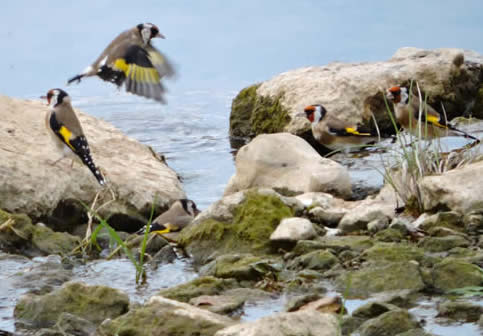

Sun in Italy/Slovenia also brought out butterflies of 29 species, some in big numbers, especially blues and
clouded yellows. Others included great banded graylings and eastern Bath whites (right; left is a group of bathing goldfinches).
Brochures are coming! The Honeyguide Wildlife Holidays brochure for 2016 has been posted and its arrival is imminent. With brochures are a Honeyguide bookmark and a leaflet on the British Dragonfly Society (BDS).
 |
The latter's purpose, naturally, is to encourage Honeyguiders to join BDS. It reflects my own enthusiasm for dragonflies and damselflies, sparked by how good my local patch of NWT Thorpe Marshes can be for these charismatic insects. 4 September |
Pau Lucio, Honeyguide's leader in Valencia and La Mancha, Spain, has been collecting information for at atlas of dragonflies and damselflies of Valencia. Here are two photos of species he recently found and kindly sent through, to whet the appetite of any odonata enthusiast. White Featherleg (left) is endemic to Iberia and SW France. The Orange-winged Dropwing (right) is widespread in Africa but doesn't occur in Europe, if you look at the map in the European dragonfly book. The reality is a spread of recent records in Iberia that seems to be linked to climate change, as for many dragons and damsels moving north.
Ivan Nethercoat and I (writes Chris) had a fascinating recce visit to Estonia in late June/early July, to plan a future Honeyguide holiday. I've never seen so many spotted flycatchers, and other birds included scarlet rosefinch and broods of goldeneyes and goosanders. The wooded meadows, roadsides and limestone grassland were incredibly rich for flowers, and highlights included lady's slipper orchids, six species of cow-wheat and spiked speedwell. Mammals were amazing, from our hosts NaTourEst's bear hide: two brown bears, a family of wild boar and raccoon dogs.

'Erratic boulders' at
Käsmu in
Lahemaa National Park, Estonia. More photos from Ivan on Flickr here and mine are on Facebook.
The French Pyrenees, as always, offered wonderful scenery, with a fine mix of wildlife. As for the weather, well, parts of every day were dry puts it positively! Lammergeiers were frequent from the hotel in Gèdre, with golden and short-eagles too, and snowfinches that were nesting in ski metalwork were the most showy we've experienced. Orchids and other flowers in the meadows were in profusion, often with butterflies that were easy to see close to hand. Holiday report here.

Cirque de Gavarnie, from Saugué. Ivan's photos and Chris's on Facebook here.
Juvenile lammergeier tagged on Crete: conservationists have attached a wing tag and a radio tracker to a young lammergeier - or bearded vulture as they prefer to call them - in the mountains of Crete. This is to trace the movements of the bird after fledging. Honeyguide's Crete holiday contributed €1000 to the Hellenic Ornithological Society towards its work.
Juvenile lammergeier on the nest; close-up and Dr Panagiotis Georgiakakis in climbing gear beside the bird. Information and pictures kindly sent by Dr Stavros Xirouchakis from Natural History Museum of Crete/HOS.
Honeyguide conservation donations reach £100,000. Recent donations - €1000 for HOS in Crete, €350 for DOPPS in Slovenia, €1000 for LPO in the Camargue and £600 for the Latvian Owl Research Society have taken our running total of conservation contributions to £100,974.
The Camargue always provides a rich mix of wildlife, starting with flamingos beside the runway as the plane landed and nightingales on arrival at the hotel. A behind-the-scenes tour with LPO of stony La Crau was a particular privilege, with little bustards, Calandra larks, red-footed falcons and a lesser kestrel colony on show.
Flamingos flying backwards in the mistral wind and exceptionally showy flowers in Les Alpilles, such as carpets of Blue Aphyllanthes and three flax species, were other highlights. As you may hear on the grapevine, one group member fell in a hotel corridor and broke her femur; she's in pretty good form after being successfully 'fixed' in Arles hospital and was flown home a few days later. Holiday report here.

Istria's wealth of wildlife was on show for Honeyguide's group in May with Paul Tout with red-backed shrike, scops owl, nightingale and golden oriole almost every day and fireflies just 100 metres from the hotel, as well as more than 30 butterfly species and 27 types of orchids in the wonderful, flower-filled meadows. A wildcat in front of the minibus at midday on the drive to the airport was a fine finale. Holiday report here.




Images from Istria: bee-eater, burnt-tip orchid, silver-studded blue and military orchids. Right: slow-worm (photos by Paul Tout). Join Paul in Italy-Slovenia this September in From the Alps to the Adriatic.
Farewell to Derek: more than 100 people gathered at Suffolk Wildlife Trust's Redgrave & Lopham Fen nature reserve on 9 May to pay tribute to Derek Moore, former SWT Director (among other things, including Honeyguide leader in Languedoc). |
 |
Derek died last October and the funeral was near his home in Wales, but this was an opportunity to remember Derek in his original homeland of East Anglia. The event MC was the BBC's Stephen Moss, and anecdotes flowed about Derek's inspirational and at times forceful personality and colourful turn of phrase. We were reminded that enthusiasm is good - and so too is anger, about wildlife losses. Derek wouldn't have wanted to be there, though ... it clashed with the Championship play-off derby between Ipswich Town FC and his beloved Norwich City FC! Left: Derek Moore OBE, 1943-2014 |
Crete's winter was cold and wet but it was warm and dry for the Honeyguide group in April 2015. Good weather meant that migrant birds were distinctly low in numbers, but nonetheless included red-throated pipit, close views of little crakes and daily alpine swifts. The winter's rain helped the flowers: from hillsides of yellow Jerusalem sage to stinky dragon arums, a fine selection of orchids and breathtaking fields of tulips and anemones on Omalos plateau. Cretan festoon and other butterflies were in fine form.

Cretan delights:
Cretan festoon; pink butterfly orchid; a chukar at Festos; a crown anemones on Omalos plateau. More photos from Crete: Chris Durdin's on Facebook and Tim Strudwick's on Flickr. Holiday report here.
Fuerteventura was surprisingly rainy for a semi-desert island for our group in late March. That didn't prevent very close views of cream-coloured coursers with chicks, houbara bustard and Fuerteventura chat. The nesting season was well under way for spectacled warblers and southern grey shrikes. Red-vented bulbuls and monk parakeets added an exotic twist - both are established aliens - and there were good sightings of turtle doves and Egyptian vultures, much declined in numbers elsewhere.

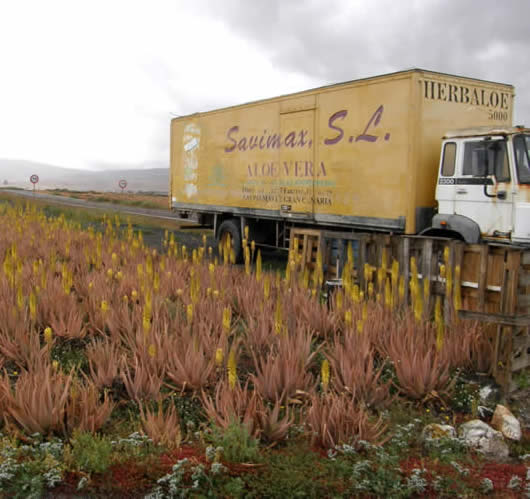


Cream-coloured courser
surrounded by the red Mesembryanthemum nodiflorum, houbara bustard, a field of Aloe vera, houbara bustard, Cistanche phelypaea & Tostón lighthouse. Photos by Helen Crowder. Holiday report here.
Honeyguide's holiday in Tarifa & Gibraltar coincided with the start of good weather. Migrant raptors were arriving across the Strait of Gibraltar, often over our base at Huerta Grande. Sunshine brought out many butterflies, including monarchs, Moroccan orange-tips and Spanish festoon. Flowers included local specialities like Lusitanian sundew and a magnificent figwort Scrophularia sambucifolia. Bonanza salt lagoons were awash with slender-billed gulls and we were privileged to see northern bald ibises on the cliff ledges where they are nesting: the reintroduction programme is going well.
Slender-billed gulls, Spanish festoon, Scrophularia sambucifolia, northern bald ibis. More photos from the holiday: Facebook gallery here. Holiday report here.
New for autumn 2015: From the Alps to the Adriatic in Italy and Slovenia, 16 - 23 September.

Little egrets and pygmy cormorants at Isonzo River (Angelo Butera) in NE Italy; Queen-of-Spain fritillary.
Honeyguide's first group of 2015 was in Extremadura in mid-February. Cranes were there in good numbers, one of the main draws, but also spring migrants like swallows, house martins and great spotted cuckoo. Other highlights were a Bonelli's eagle hassling a golden eagle, good views of Spanish imperial eagle and big flocks of Spanish sparrows.
Dappled white butterflies (right) and angel's tears narcissi were other signs of spring. The itinerary included an excellent new site, a reservoir at Alcollarín. A tight flock of some 40 little bustards was notable as this bird is in decline in the region for unexplained reasons. Report here.




Undulate anchusa, Spanish imperial eagle, Angel's tears narcissi, great white egret and wagtails at Alcollarín reservoir. More photos on Facebook here.
White and black gold in Istria: a reminder of Paul Tout's account of timber and truffles. A good read for travellers, historians or cooks. Click here for the full story. There are still places on our Istria holiday.

This picture is of cranes flying to roost in Gallocanta, Aragón in Spain, and was taken on 24 January 2014 by Pau Lucio, Honeyguide leader in La Mancha. Pau says: "The number of cranes was between 17,000 and 18,000. Apparently there are more cranes than in previous weeks as a result of cold weather in France. Nevertheless, that is nothing compared with the 48,663 cranes than wintered last year in Gallocanta (a record); a hailstorm damaged many of the crops so there was a lot of food for them."
This comes shortly before a Honeyguide group goes to crane country in Extremadura. The results of the January 2015 Extremadura crane census showed a new record, with a total of 139,101 birds counted. This is all linked to the steady growth in crane numbers and their westward spread as a breeding bird, recolonising parts of their former range, including the UK. See also The Norfolk Cranes' Story.
Walking in the Peloponnese: Honeyguiders in the Peloponnese will remember Sue Davy's friend Wendy Copage, who gave lots of practical help to our groups, helped by her great local knowledge and fluent Greek.
 |
Wendy has now set up her own business running walking holidays in 'our' bit of the Peloponnese, based at Tyros. Called Greece on Foot, you can contact Wendy via the website www.greeceonfoot.com. |
Short break opportunity to see wallcreepers in Istria and the Karst
This year has been a good one seeing wallcreepers, but those who weren't with Honeyguide in the Pyrenees or Bulgaria may enjoy a chance to see them early in 2015. Honeyguide leader Paul Tout has arranged a short — four nights — wallcreeper break in Istria and the Karst from 25 February to 1 March 2015.
This is timed for when wallcreepers winter in the lowlands and close to the coast, but also for when days are growing and there are signs of spring along with the winter birds. We know this is quite soon, but it might appeal to some people either at short notice or as an idea for a future year - if so, we'd love to know that. We could also do it as a three night break (a long weekend) or perhaps on different dates that suit you, ideally for a small group of 4-7 people. |
 Wallcreeper (Assen Ignatov) More information about the wallcreeper break here. |
Honeyguide Charity update
Donations to the conservation projects we support totalled £5,765 in 2004. As always, this money is nearly all raised by the £40 conservation contributions included in the holiday price, topped up by Gift Aid through the Honeyguide Wildlife Charitable Trust.
These donations bring our running total of money raised to £97,380 — we should reach the milestone of £100,000 in the first half of 2015.
  |
There were two donations this autumn. The first was £660/€785 to La Ligue pour Protection des Oiseaux (LPO) in the French Pyrenees, towards protecting lammergeiers, a project we've supported for many years. There's information about how lammergeier numbers have grown, thanks to LPO and its partners, on our French Pyrenees web page. The second, for £700, on our La Mancha holiday, was to the bird ringing group in Valencia called Grupo de Anillamiento Pit-Roig. Recent highlights in the group's work are described in our La Mancha holiday report. We're always pleased to accept additional donations, which can be for projects/places close to your heart or left to our discretion. |
Have I got old news for you? . . . News 2024 . . . News 2023 . . . News 2022 . . . News 2020-21 . . . News 2019 . . . News 2018 . . . News 2017 . . . News 2016 . . . News 2014 . . . News 2013 . . . News 2012 . . News 2011 . . . News 2010 . . . News 2009 . . . News 2008
Back to current news page




















